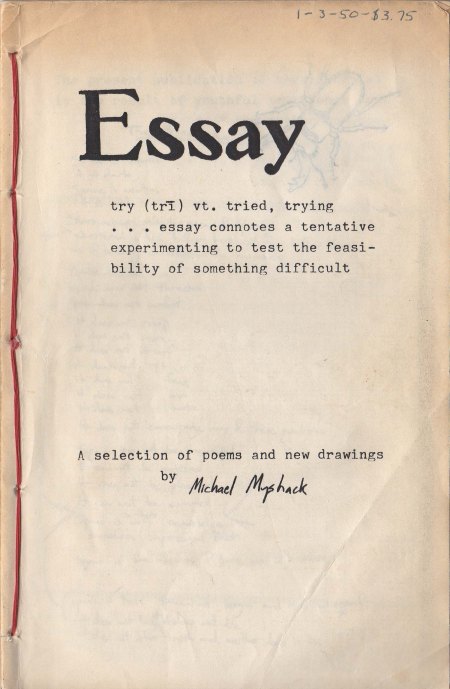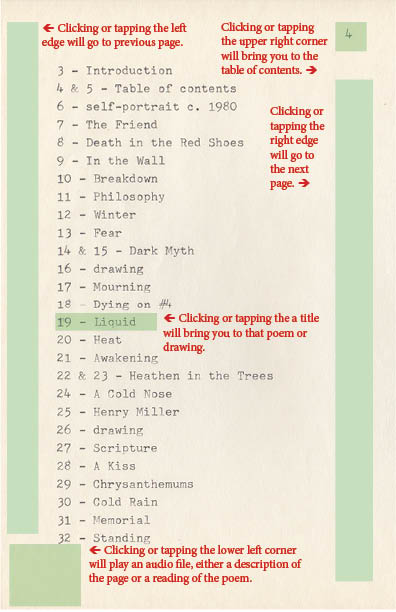For over 30 years I’ve wanted to produce books that include not just my words but also my drawings/paintings. Back then it was impossibly expensive, even to do it in black and white. Adding audio to my repertoire in 1996 put it even farther out of my reach.
Now we have digital publishing. The possibilities are overwhelming. They are more titillating and frustrating than satisfying, because there is no universally readable format. (Pariah Burke lists the current formats, their pros and cons, in ePublishing with InDesign CS6. Discussed are: EPUB, PDF, digital replica, interactive magazine, and HTML—and the variations of each.)
But, it’s fairly affordable.
I decided to start with something already in existence, a chapbook I produced in 1984. It was called Essay (verb, to try something difficult) and was my first foray into self-publishing. Originally it was printed by a quick printer in black ink, no half-tones, on highly acidic paper. The text was done on an old office typewriter (manual, not electric) by a not-so-competent typist (me) with drawings that were pretty basic and, so I thought, easily copied (they weren’t, because I couldn’t afford to do half-tones). I knew so little about making books that I even botched the binding (see photo below), stitching from the side rather than through the spine (side stitching is common in traditional Japanese binding, I love the look of it and use it from time to time, but what I did with Essay was nothing but incompetence).…I made 50 copies. A few friends bought them. The Amazing Alonzo’s paperback exchange in Duluth put a couple on the shelf on consignment (I was a good customer). Cheng-Khee Chee, then head librarian of the UMD library, graciously bought a copy.

The cover of Essay, 1984, showing the inept binding.
The first step was to scan all my original printer spreads (yes, I still have them) and then break them into individual pages. The awkward part of this book, and what makes it a poor choice for a first try, is that it’s all images. Ordinarily you’d create a book in InDesign or QuarkXPress by creating text and image boxes that will reflow to fit the screen of the viewing device, depending on what format you choose to export this as. I still might try to do this one as a fixed image epub, like a children’s storybook.
The first attempt at interactivity was to add navigation. Because I didn’t want to do anything to conflict with the look of the original I did not create visible buttons. So far everyone who’s played with this has found the navigation buttons pretty quickly (most of them are what you’d find in any format of epublishing).
Then I decided to take a step into the future (or recent past) by adding audio. I read a description of each page or read the poem. Conscientious artisan that I am, I cleaned the background noise from the recording (that would be the fan on my computer), compressed the vocal to make it more consistently audible, tweaked the EQ (also to make it a little easier to hear), and added a pinch of reverb to make it more aesthetically pleasing. Of course almost all this work disappeared as soon as I converted the files to 32-kbps MP3 files—sounds like shit but it makes the overall document file more internet friendly (it’s still about 10MB).
It’s easy to embed any kind of media file into an InDesign document. A little file player is created that can be placed anywhere on the page.…On playback of the finished PDF I found it becomes an ugly gray box that won’t go away until the file is reopened. It took some fooling around to find a place that was consistent from page to page but would never cover any of the text.

Here I define all the navigation points and the button for the audio player.
What seemed like an almost universally supported file format, the PDF, has failed everywhere except on PCs. It only worked the way a printable PDF would on Macs and mobile devices, both Android and Apple operating systems. That is, the navigation buttons still worked. It seems that InDesign creates a Flash player when embedding the audio. (I need to further explore what’s happening. So far my searches have not been informative, much less suggesting alternatives.)…I tried attaching the audio files in Acrobat, which also worked on my desktop. On my NOOK HD this version would no longer open the PDF reader navigation with page thumbnails.
Click the link below for a fully operational copy of the book. Your feedback is welcome.
essay interactive electronic 2013
Okay…I tried a preview on my computer, a PC running Vista 64-bit, and everything worked.
As I continue to explore electronic publishing I’ll keep you posted at this blog. I’m looking into other possibilities as well, such as a bonus feature with a CD download (a printable PDF with images and text).
Addendum, March 7, 2013: Because people are running into the same difficulties playing the uploaded PDF as they had at home when various family members tested it (no audio on Macs or mobile devices) I’ve uploaded the audio to soundcloud.com. To hear the continuous set go to the sets tab or to the sounds tab for the individual tracks (which can be downloaded, for your convenience). One thing to say in favor of the recordings posted on SoundCloud is that they are higher quality than the 32 kbps mono versions embedded in the PDF. They are 256 kbps “stereo”. Supposedly CD quality.

